Manufacturers are becoming increasingly concerned about the purity of their finished pharmaceutical preparations. Trace amounts of residual synthesis by-products, impurities in the synthesis chemicals, or decomposition of finished pharmaceutical product are often present in finished pharmaceutical preparations in levels down to parts per million (ppm) and a method is needed to detect and identify these impurities.
The technique of Direct Thermal Analysis utilizing the Short Path Thermal Desorption System permits the analysis of solid samples without the need for prior solvent extraction or other sample preparation. Using this technique, it is possible to analyze solid pharmaceutical samples to determine the solvent residues and impurities remaining after manufacture. Sample sizes ranging between 1 milligram and 250 milligrams of the pharmaceutical in question were inserted directly into the Glass Lined Stainless Steel (GLT) Thermal Desorption Tube. The new "Short Path Thermal Desorption System" was utilized to permit the direct sparging of the volatile and semi-volatile components from the solid pharmaceutical samples directly into the GC injection port with subsequent GC and MS analysis. Neither solvent extraction nor the use of vapor traps were required. This technique permits the maximum sensitivity of analysis due to this direct injection technique.
The Scientific Instrument Services' "Short Path Thermal Desorption System" was attached to the injection port of a Hewlett-Packard 5971 GC/MSD. A J&W DB-5, 25 m x .25 mm, 0.25 u film thickness capillary column was used for this study. The GC was used in the splitless mode at the flow rate of 0.5 ml/min.
Experimental
Sample sizes of 1 to 250 milligrams of various solid pharmaceuticals were placed directly inside the 1/4" x 4" long GLT desorption tubes between two quartz wool plugs. These tubes were then attached to the Short Path Thermal Desorption System and fitted with a syringe needle. The sample was flushed with helium carrier gas for 1 minute and then autoinjected into the GC injection port. The desorption system heating blocks were previously heated to the sparging temperature indicated and closed around the desorption tube to heat the tube with enclosed sample. This sparges any volatile or semi-volatile materials into the GC injection port where they were subsequently trapped in a narrow band at the front of the GC column which had been previously cryo-cooled to -40 degrees C. The sample was sparged and the volatiles collected for 10 minutes after which the GC was temperature programmed at 10 degrees per minute up to 280 degrees C, to elute the components which were then subsequently analyzed via the Mass Spectrometer.
Results and Discussion
TYLENOL (Acetaminophen). Two (2.0) milligrams of Tylenol were sparged at 150 degrees C into the GC injection port. The major peak in the chromatogram was due to acetic acid. Also present in the chromatogram were Phenol (14.94 min.), 2-hydroxy Benzoic Acid (20.30 min.), Acetanilide (21.09 min.), and several other minor constituents. The base compound Tylenol (Acetaminophen) was not observed because the sample was only sparged at 150 degrees C; the melting point of acetaminophen is 170 degrees C. Had the acetaminophen been eluted, it would have overloaded the GC column due to its high concentration in the pharmaceutical preparation. The only materials observable were due to minor impurities in the pharmaceutical preparation from residual synthesis by-products or impurities in the synthesis chemicals. The concentration of these residues range from ppm to ppt. This technique could prove useful in manufacturing to monitor the purities of finished pharmaceutical products.
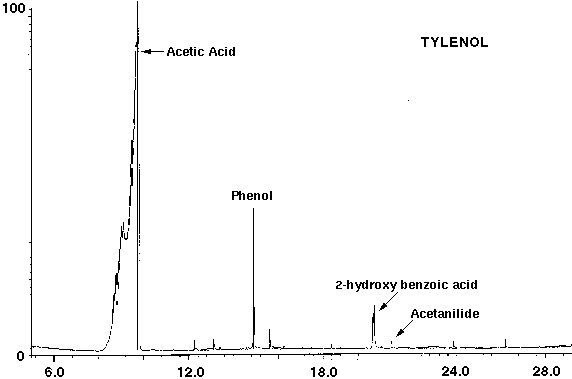
Figure 1 - TYLENOL, 1 mg, Direct Thermal Desorption, Desorb At 150 Degrees C For 5 Min. GC Column DB-1, .25 mm x 25 meter, .25µ film. Temp. program -40 degrees C to 280 degrees C at 10 degrees /min
BENADRYL (Diphenhydramine). The entire contents of one Benadryl capsule, (25 milligrams of diphenhydramine) was sparged at 100 degrees C into the GC injection port. Low temperatures are required due to the relatively low boiling point of diphenhydramine) at 150 degrees C. Even still, a small peak of diphenhydramine at 37.7 minutes was observed. Other observed peaks due to manufacturing residual compounds and impurities in these compounds were observed as indicated in the chromatogram 2.
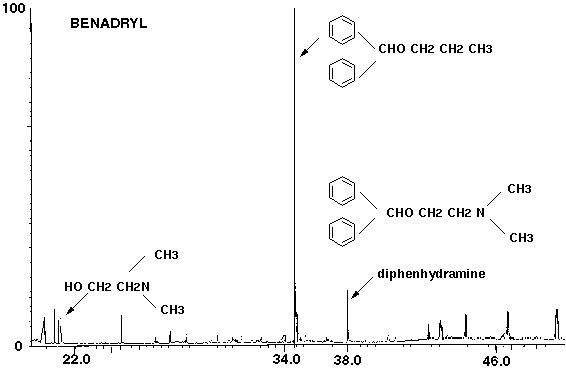
Figure 2 - BENADRYL, 25 mg, Direct Thermal Desorption, Desorb At 100 Degrees C For 10 min. GC Column DB-5, .25 mm x 25 meter, .25 µ film. Temp. Program -40 Degrees C To 280 Degrees C At 10 Degrees /min.
PENICILLIN. Ten (10.0) milligrams of an old (3 years) tablet of Penicillin was sparged at 125 degrees C into the GC injection port. A large number of compounds were detected which were possibly due to breakdown of the Penicillin with time or due to contamination of the original material. In addition, the solvent Butyl Carbitol (28.43 minutes) and the antioxidant BHT, Butylated Hydroxytoluene, (33.17 minutes) were also identified. This technique could not only be used to monitor impurities in pharmaceutical products during manufacture, but could also be utilized to detect and identify pharmaceutical decomposition with time.
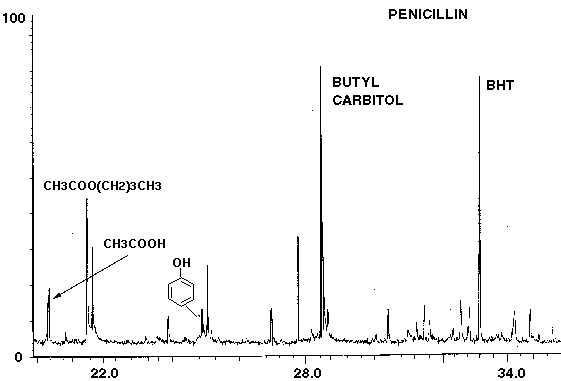
Figure 3 - PENICILLIN, 10 mg, Direct Thermal Desorption, Desorb At 125 Degrees C For 10 min. GC Column DB-5, .25 mm x 25 meter, .25 µ film. Temp. Program -40 Degrees C To 280 Degrees C at 10 Degrees /min.
BUFFERIN. One (1.0) milligram of Bufferin was sparged at 150 degrees C into the GC injection port. The compounds detected and identified include acetic acid and salicylic acid, precursors for the synthesis of aspirin. In addition, phenol and several other compounds were detected.
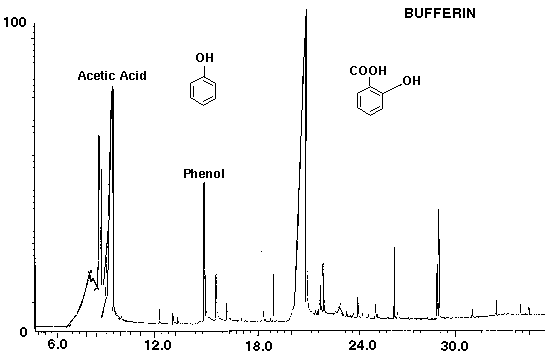
Figure 4 - BUFFERIN, 1 mg, Direct Thermal Desorption, Desorb At 150 Degrees C For 5 min. GC Column DB-1, .25 mm x 25 meter, .33 µ film. Temp. Program -40 Degrees C To 280 Degrees C At 10 Degrees /min.
MARIJUANA. (Courtesy NJSP). A three (3.0) milligram sample of the dried vegetation of Marijuana was sparged into the GC injection port at 200 degrees C. This relatively high temperature was required in order to observe the peaks for the active components in Marijuana, i.e. THC. At lower sparging temperatures, the THC and related components were not observable. In addition, a wide variety of terpenes (M.W. 136), hydroxy terpenes (M.W. 154) and sesquiterpenes (M.W. 204) were also detected. The patterns of these terpenes could be used in a forensic application to characterize the vegetation as to source of origin. This technique could prove to be an extremely useful method to positively identify Marijuana and its active ingredient THC via methodology which does not use solvents for extraction or the TLC method which uses Benzene as its solvent. This would be beneficial both for the environment and the health of the forensic scientists.
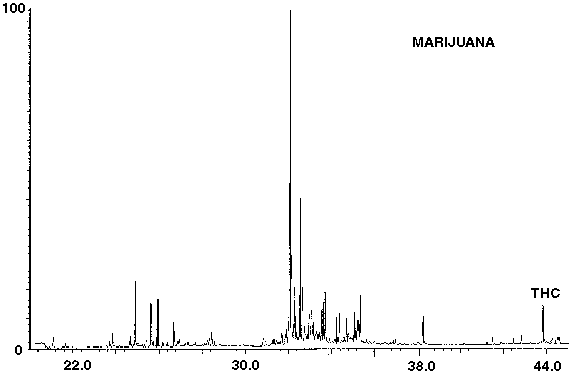
Figure 5 - MARIJUANA, 3 mg, Direct Thermal Desorption, Desorb At 200 Degrees C For 10 min. GC Column DB-5, .25 mm x 25 meter, .25 µ film. Temp. Program -40 Degrees C To 280 Degrees C At 10 Degrees /min.
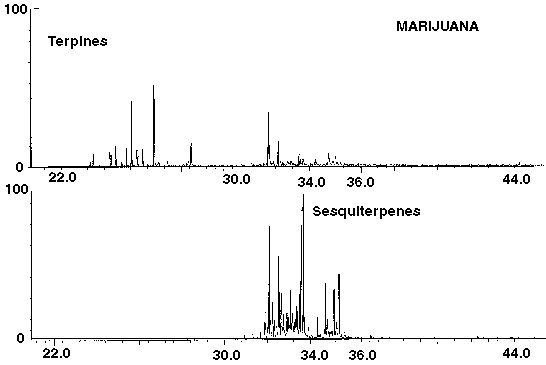
Figure 6 - MARIJUANA, 3 mg, Direct Thermal Desorption, Desorb At 200 Degrees C For 10 min. GC Column DB-5, .25 mm x 25 meter, .25 µ film. Temp. Program -40 Degrees C To 280 Degrees C At 10 Degrees /min.
Conclusion
The technique of Direct Thermal Analysis utilizing the Short Path Thermal Desorption System has proven to be a useful technique for the analyses of Pharmaceutical samples in order to identify the residual solvents, volatiles, and semi-volatiles present in these samples after manufacture or due to the decomposition of the pharmaceutical samples. Sample sizes ranging from one milligram to 250 milligrams of the pharmaceutical sample can be analyzed via this technique by directly sparging the volatile and semi-volatiles into the GC via the shortest path possible. Components in the ppm to ppt are readily detected in the presence of high concentrations of the pharmaceutical sample by careful selection of the sparging temperature. By analyzing the pharmaceutical sample directly without the use of solvents or traps, the maximum sensitivity of analysis is possible without the possibility of outside contamination of the sample from other sources.
1 comment:
Somu Solvents Pvt. Ltd. Provides Ethyl 3 Ethoxypropionate, Ethylene Glycol Diacetate, Ethyl 3 Ethoxypropionate, Ethylene Glycol Diacetate, Butyl Diglycol Acetate, 2 Ethylhexyl Acetate, 1 Methoxy 2 Propanol Propionate Manufacturers in India.
Post a Comment